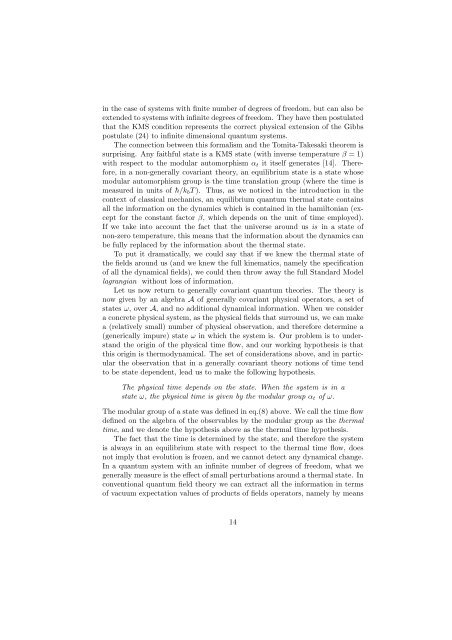Von Neumann algebra automorphisms and time ... - Alain Connes
Von Neumann algebra automorphisms and time ... - Alain Connes
Von Neumann algebra automorphisms and time ... - Alain Connes
You also want an ePaper? Increase the reach of your titles
YUMPU automatically turns print PDFs into web optimized ePapers that Google loves.
in the case of systems with finite number of degrees of freedom, but can also be<br />
extended to systems with infinite degrees of freedom. They have then postulated<br />
that the KMS condition represents the correct physical extension of the Gibbs<br />
postulate (24) to infinite dimensional quantum systems.<br />
The connection between this formalism <strong>and</strong> the Tomita-Takesaki theorem is<br />
surprising. Any faithful state is a KMS state (with inverse temperature β = 1)<br />
with respect to the modular automorphism αt it itself generates [14]. Therefore,<br />
in a non-generally covariant theory, an equilibrium state is a state whose<br />
modular automorphism group is the <strong>time</strong> translation group (where the <strong>time</strong> is<br />
measured in units of ¯h/kbT ). Thus, as we noticed in the introduction in the<br />
context of classical mechanics, an equilibrium quantum thermal state contains<br />
all the information on the dynamics which is contained in the hamiltonian (except<br />
for the constant factor β, which depends on the unit of <strong>time</strong> employed).<br />
If we take into account the fact that the universe around us is in a state of<br />
non-zero temperature, this means that the information about the dynamics can<br />
be fully replaced by the information about the thermal state.<br />
To put it dramatically, we could say that if we knew the thermal state of<br />
the fields around us (<strong>and</strong> we knew the full kinematics, namely the specification<br />
of all the dynamical fields), we could then throw away the full St<strong>and</strong>ard Model<br />
lagrangian without loss of information.<br />
Let us now return to generally covariant quantum theories. The theory is<br />
now given by an <strong>algebra</strong> A of generally covariant physical operators, a set of<br />
states ω, over A, <strong>and</strong> no additional dynamical information. When we consider<br />
a concrete physical system, as the physical fields that surround us, we can make<br />
a (relatively small) number of physical observation, <strong>and</strong> therefore determine a<br />
(generically impure) state ω in which the system is. Our problem is to underst<strong>and</strong><br />
the origin of the physical <strong>time</strong> flow, <strong>and</strong> our working hypothesis is that<br />
this origin is thermodynamical. The set of considerations above, <strong>and</strong> in particular<br />
the observation that in a generally covariant theory notions of <strong>time</strong> tend<br />
to be state dependent, lead us to make the following hypothesis.<br />
The physical <strong>time</strong> depends on the state. When the system is in a<br />
state ω, the physical <strong>time</strong> is given by the modular group αt of ω.<br />
The modular group of a state was defined in eq.(8) above. We call the <strong>time</strong> flow<br />
defined on the <strong>algebra</strong> of the observables by the modular group as the thermal<br />
<strong>time</strong>, <strong>and</strong> we denote the hypothesis above as the thermal <strong>time</strong> hypothesis.<br />
The fact that the <strong>time</strong> is determined by the state, <strong>and</strong> therefore the system<br />
is always in an equilibrium state with respect to the thermal <strong>time</strong> flow, does<br />
not imply that evolution is frozen, <strong>and</strong> we cannot detect any dynamical change.<br />
In a quantum system with an infinite number of degrees of freedom, what we<br />
generally measure is the effect of small perturbations around a thermal state. In<br />
conventional quantum field theory we can extract all the information in terms<br />
of vacuum expectation values of products of fields operators, namely by means<br />
14


